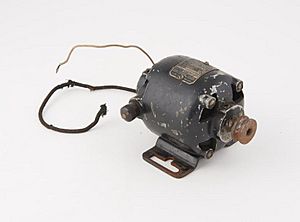Dorothy Smith (1898-1975) facts for kids
Quick facts for kids
Dorothy Smith
|
|
|---|---|

Smith in 1958
|
|
| Born | 10 February 1899 |
| Died | 22 February 1975 (aged 76) Leamington Spa, Warwickshire, England
|
| Occupation | Chartered Electrical Engineer |
| Known for | Chairman of Manchester Branch of the Women's Engineering Society 1943-45, second woman to achieve Full Membership of the Institution of Electrical Engineering in 1958 |
Dorothy Smith (born February 10, 1899 – died February 22, 1975) was a pioneering electrical engineer. She worked for a big engineering company called Metropolitan-Vickers (which used to be British Westinghouse) for 43 years, from 1916 until she retired in 1959. Dorothy was only the second woman ever to become a full member of the Institution of Electrical Engineers. The first was Hertha Ayrton way back in 1899. Dorothy was also a very important member of the Manchester group of the Women's Engineering Society.
Contents
Early Life and Education
Dorothy was born in Stretford, Lancashire. Her parents were James H Smith and Amelia Smith. She went to the Manchester High School for Girls with a special scholarship. Her favorite subject was math, which made her want to apply for a job at British Westinghouse.
During World War I, many men went to fight, so there weren't enough workers in factories. This meant companies like British Westinghouse started hiring women for the first time. Dorothy was one of the first female apprentices (trainees) they took on.
Her Engineering Career
Dorothy started at British Westinghouse in 1916. She began as a junior trainee in the Transformer Drawing office. This is where they drew plans for electrical transformers. She quickly moved to the Electrical Engineering Department. After a year, she started designing small motors in the Induction Motor section.
While working, Dorothy also studied part-time at the Manchester College of Technology. After five years, she earned a special degree in Electrical Engineering.
Designing Motors
In 1930, Dorothy helped design new types of motors. These were called RS- and RW-type motors. They were better because they had improved ventilation and were smaller. In 1934, she moved to the British Thomson-Houston Company for three years. Her job was to help connect the sales team with the engineers, thanks to her experience with motor designs.
Dorothy returned to Metropolitan-Vickers in 1937. She then started designing small direct current motors. These motors were used on ships during World War II.
Standing Up for Women
In 1937, Dorothy took part in a debate at her company. The topic was "That the Introduction of Female Apprentices to these works is to be deplored." This means some people thought it was a bad idea to hire female trainees. Dorothy argued against this idea. She was joined by other women engineers like Dorothy Garfitt, Anne Gillespie Shaw, and Gertrude Lilian Entwisle. In the end, the idea to stop hiring women was defeated by a vote of 78 to 61.
From 1947 until she retired in 1959, Dorothy was in charge of creating detailed lists of special "flameproof" motor designs. These motors were safe to use in places where there might be explosions. She also showed these designs to the Ministry of Power, a government department.
Joining Professional Groups
Dorothy Smith became an Associate Member of the Institution of Electrical Engineers in 1927. Then, in 1958, she achieved the highest level: Full Membership. She was the first woman to do this since Hertha Ayrton in 1899.
She also joined the Women's Engineering Society (WES) in the early 1920s, soon after it started. She remained a special member until she passed away in 1975. Dorothy held many important roles in WES. She was the first Treasurer of the Manchester group in 1943. She was also the Chairman of the Manchester group from 1943 to 1945. She was part of the main Council from 1947 until her retirement in 1959. In 1965, she was made an Honorary Member.
Retirement and Later Life
Dorothy Smith retired from Metropolitan-Vickers on April 7, 1959, after 43 years. Her co-workers said that her life and career were a great example for any young woman who might think that success in engineering was only for men.
After retiring, she moved away from the Manchester area. Dorothy passed away on February 22, 1975, at a nursing home in Leamington Spa. Her obituary for the Women's Engineering Society was written by her colleague, Isabel Hardwich.


